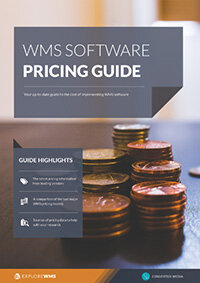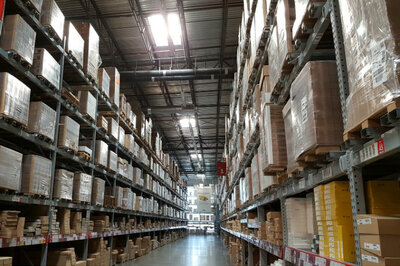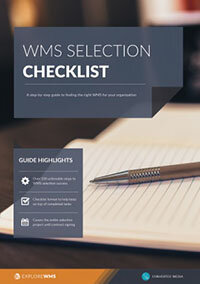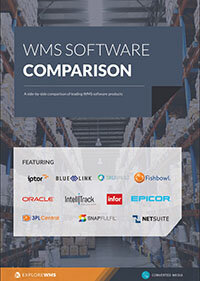How much WMS software costs and how to set your budget
We often get asked: how much will a warehouse management system cost?
WMS providers aren't always forthcoming with their system pricing which can make it difficult when determining how much you can expect to pay for your WMS system. Although your system cost isn't the only consideration, many different factors can cause your WMS budgets to shift significantly.
We've created this step-by-step guide on how much WMS costs to assist you in creating your budget for your next selection project.
It is always advisable to seek out multiple bids for your project and work with vendors to understand your needs and which features will meet them. This step-by-step guide covers costs associated with WMS selection and implementation from start to finish, including:
- Considering WMS pricing model and deployment options
- Calculating WMS installation costs
- Deciding on which WMS features you need
- Figuring out any hidden costs
- Bringing your WMS budget together [infographic]
Our WMS cost information comes from conversations with vendors, consultants, and WMS users and publically available information from 45 WMS vendors. Costs quoted should be used as an estimate as each project is different.
1. Consider which WMS pricing model you need
The vast majority of WMS will fall into one of two pricing models: perpetual licensing or a subscription model (typically monthly). Both initial budgets and annual budgets will shift based on the deployment model you select.
The biggest differentiator that most warehouses will find between these two models is that a perpetual license is commonly used with on-premise solutions while the subscription model operates in the Software-as-a-Service (SaaS) model and uses the cloud for some of your data storage or processing.
GET WMS RESEARCH & KNOWLEDGE RIGHT TO YOUR INBOX
Covering the key issues faced by businesses selecting and implementing WMS.
In the aggregate, your first year is likely the most expensive due to costs associated with installation, configuration and training even when considering maintenance and upkeep costs.
SaaS subscription
The latest WMS pricing research found that businesses, on average, spend $167 per user per month for their system.
You should expect to pay at least $100 per user for entry-level services that have a basic level of functionality. This comes to roughly $500 per facility because the vendors we spoke to said warehouses average five users during their first WMS installation.
Packages that include more functionality, such as fleet management tools or analytics designed to increase picking efficiency, and those that are better suited to integrating with multiple suppliers’ software, can move to between $200 and $300 per user, or $1,000 to $1,500 per facility, per month.
Enterprise-grade subscription services that are tailored to large warehousing operations or include advanced functionality, such as tools that help you create a sophisticated audit trail or maintain industry compliance can reach as high as $500 per user or up to about $5,000 per facility, per month.
Use our comprehensive WMS pricing guide to estimate initial WMS cost and inform budgeting decisions
Subscription plans will often have a small upfront cost, with many free-trial options and cost reductions for the first six months to one year. The goal for vendors is to secure your business and have you learn the platform at a reduced rate.
The good news is that integration with your platforms and those of your customers is usually covered during this low-cost phase, creating significant savings (at least in the short-term) to on-premise solutions which require customization.
"It is important to discuss pricing changes with vendors and budget for that jump ahead of time"
Installation and general setup also fall into this initial bucket and are typically kept low so that a SaaS provider can keep you as a customer after the trial period ends.
In most cases, the more users you pay for, the more cost-efficient these services become.
When your trial period ends or first subscription renews, you will likely see a higher recurring cost due to the entry-level price wearing off. This is not always the case, but it is important to discuss pricing changes with vendors and budget for that jump ahead of time to ensure you choose an option that’s affordable for your operations.
Many WMS are offered in conjunction with suites of other products, so you may see costs rise for the inclusion of labor optimization elements, customer relationship management tools, or predictive analytics platforms that use data from other modules offered by your WMS vendor.
Small additions like enhanced order management systems can cost as little as an additional $100 per warehouse per month, while larger additions such as a full CRM may yield a percentage discount on a service that costs thousands of dollars each month.
Pricing can be tricky with some subscription options because you may have to purchase blocks of licenses, such as paying $1,000 per month for up to five users. So, look for options that allow you to buy only the licenses that you need and can scale as demand grows.
Perpetual licenses
Software packages that rely on a perpetual license fee structure often have significantly high upfront costs because you’re purchasing the software outright. In these models, your vendor is getting the bulk of their payment from you on the front end, so that recurring service costs tend toward being small and related to options, upgrades, and support.
Your entry-level WMS with a perpetual license will start at around $2,500 per facility. This includes limited automation and inventory support – often limiting scope or not including methods to track goods through various channels or shipping lanes. Baseline models that support retail applications, such as those that tie into the stock rooms at a few locations but don’t automate fill orders will run up to roughly $10,000.
"Your entry-level WMS with a perpetual license will start at around $2,500 per facility"
Growing operations that reach the mid-range of services and automation, with varying degrees of complexity and industry specificity, should budget for a cost range from $10,000 to $50,000 per facility. Some of the cost you’re paying for here is the ability to validate orders, support more picking or handheld devices, and receive updates automatically.
If your WMS integrates with software that updates each year, such as QuickBooks, make sure your license covers WMS upgrades to maintain software compatibility and support.
Enterprise-grade WMS that support the latest in robotics and automation software, integrate with suppliers and carriers, provide analytics, and can integrate with specialty assembly or manufacturing lines can cost anywhere from roughly $20,000 to more than $200,000 for your organization. These systems have an extreme range in features and costs, so a proper budgeting process necessitates multiple conversations with potential vendors.
Table showing initial WMS cost for on-premise and SaaS deployments
| Entry level functionality | Mid-range functionality | Enterprise | |
|---|---|---|---|
| SaaS (per user/month) | $100 | $300 | $500 |
| Perpetual license (per facility) | $2500-$10,000 | $10,000-$50,000 | $20,000-$200,000 |
| Suited to | Companies with limited automation and inventory support – often not including methods to track goods through various channels or shipping lanes. | Growing operations requiring mid-range of services and automation, with degrees of complexity/industry specificity | Enterprises requiring latest automation software, integration with suppliers, advanced analytics, or integration with specialty assembly lines |
Initial costs will be high so if you’re planning on trying out multiple WMS or expect your operations to shift, - if more customers are moving to an e-commerce model - on-premise may not be right for you. Installation and integration also come with a higher ticket price for on-premise software due to the infrastructure required.
Another important note is that long-term costs associated with on-premise typically stay low, so there’s usually a break-even point for a perpetual license and subscription model between years five and seven. This makes a perpetual license a better deal the longer you stick with the system. Keep that in mind when considering these average WMS prices.
"Another important note is that long-term costs typically stay low so there’s usually a break-even point for a perpetual license and subscription model between years five and seven"
A few major software brands provide perpetual license models on a per-application-user basis and set a minimum of users that you need to purchase, similar to a subscription model.
2. Calculate any WMS installation costs
When budgeting for your new WMS, be aware that Installing and setting up your warehouse management system may come with costs that are not included in the licensing or subscription pricing your vendor provides.
Installation and customization
On-premise systems will have higher installation costs, but these vendors also are more likely to provide customization services as part of the installation package. Getting you up and running usually includes verification of databases, integration, and configuration. Enterprise platforms tend to cost about $10,000 for installation and customization, while entry-level systems average closer to $2,000.
High-end SaaS systems, WMS and otherwise, will likely have setup and configuration costs as the practice is becoming more common in the industry. Customization and integration fees plus an initial setup will vary significantly based on your system and your integration partners. A safe estimate is $5,000 for a mid-range system.
Table showing WMS installation costs for on-premise and SaaS deployments
| Entry level | Mid-range | Enterprise | |
|---|---|---|---|
| On-premise | $2000 | $5500 | $10,000 |
| SaaS | $1000 | $5000 | $7000 |
One budgetary benefit of SaaS providers is that they tend to have fewer additional costs associated with applying updates. You may incur some of these for an on-premise solution that requires your vendor to manually perform an update or future customization.
Maintenance and support
Smart WMS budgets look at the long-term use of a system, including costs to keep everything running smoothly.
On-premise, perpetual license WMS packages tend to come with a separate annual maintenance cost as part of your contract. This covers updates, upgrades, security patches, and tech support for your software.
In the perpetual license space, the annual maintenance cost can range from 10% to 20% of your WMS' license cost, though they’re often reduced for an initial period of time. When the contract expires and needs to be renewed, expect a 1% to 2% increase in cost with each new contract.
SaaS vendors may bundle maintenance and support costs into your overall subscription pricing. What you may pay for is a premium level of support that can include elements like dedicated support teams, remote monitoring, and extra backup support. Pricing for these packages varies greatly, so expecting a 5% to 10% price addition will help you budget for this support adequately.
Table showing total WMS setup costs for on-premise and SaaS deployments
| Entry level | Mid-range | Enterprise | |
|---|---|---|---|
| On-premise deployments | |||
| Installation & customization | $2000 | $7000 | $10,000 |
| Maintenance & support | $400 | $1400 | $2000 |
| Total installation costs | $2400 | $2000 | $12,000 |
| SaaS deployments | |||
| Installation & customization | $1000 | $5000 | $7000 |
| Maintenance & support | $100 | $500 | $700 |
| Total installation costs | $1100 | $5500 | $7700 |
3. Decide which WMS features you need
There are some functions of a warehouse management system that are supported in most core implementations, but many are only found in mid-range or enterprise systems.
Table showing examples of entry level, mid-range and enterprise WMS features
| Entry level | Mid-range | Enterprise |
|---|---|---|
| Inventory management | Picking optimization | Dynamic slotting |
| Order fulfillment | Custom user dashboards | IoT automation |
| Receiving | Real-time analytics | Industry compliance support |
| Barcode scanning | Fleet and asset management | Industry complliance support |
| Shipping | Capacity planning | Advanced analytics and forecasting |
Typically, you’ll pay more as your WMS supports more of these features. Treat these items as options for a checklist you might want to bring to potential vendor partners to see what support they provide.
4. Forecast for any ‘hidden’ WMS costs
Training your staff
You should expect to have three to five days of training for your staff on the new warehouse management system. This will allow you to train in shifts and give teams time to practice and come back with questions while training teams or services are available.
"Adopting a new WMS may come at a time of growth, so be sure to include a budget for training new team members as well as providing additional training each year to existing staff"
Depending on your vendor, they may offer a training center for your team to visit, send trainers to your site to train teams on your specific equipment, or provide self-study content like webinars and system documentation. Self-study elements are no longer bare bones support, as some vendors can create custom documentation and training content based on your industry, equipment, and operations.
Adopting a new WMS may come at a time of growth, so be sure to include a budget for training new team members as well as providing additional training each year to existing staff.
If your vendor provides hands-on training, expect it to cost between $3,000 and $5,000 for your team. When a vendor estimates this cost, it usually covers training at a single location, whether your site or theirs, so your budget may need to increase if you want or need training at multiple sites. No vendor we spoke to noted a class size limit, but that concern is worth discussing if you have a large team.
Vendors who pair digital learning content with phone or email support tend to have a lower overhead thanks to online delivery, so the average cost is roughly $2,000 for your team’s first year.
Improving your infrastructure
Your existing equipment may not work best with your WMS. This is especially true for old IT infrastructure for on-premise solutions and old scanning or barcode equipment when using new SaaS models.
On-premise solutions may require upgrades for your database servers, networking hardware, and the PCs running your WMS. If you’re purchasing a newer warehouse management system, expect it to have a higher level of equipment requirements.
Hosted models save you the trouble of not needing additional server hardware, but they will require a computer with mid-level specs as well as a reliable, fast Internet connection. Big purchases in this arena often come from backup systems customers layer on top of their cloud storage. Many businesses want to have a local copy of their data so that operations don’t grind to a halt if connectivity is lost.
General IT staff time
Like infrastructure spending, the IT staff and maintenance element is hard to predict because it depends on your system, the scope of your licensing or use, and the capabilities of your IT team.
You will need to allow your IT staff time to maintain and update your system periodically, which can also include consulting fees and business costs to educate your team on proper maintenance.
The time it takes and the amount of spend can vary significantly, so the big takeaway here is to understand that your IT staff will have new responsibilities with your WMS and need to be given time to see to theses duties.
Using your data
Big Data is a core focus for companies looking to run more efficiently. It is present in a number of WMS functionalities, from optimizing inventory and picking to choosing shipping lanes and consolidating loads. However, some WMS users have noted that they required additional software or staff time to run advanced analytics and generate valuable insight.
Typically, you will need a larger budget for analytics platforms, either to pay for it as an add-on to your service or for a more robust offering.
Enterprise-level platforms include analytics and asset management in their feature list more often, but many of the small and mid-sized tools either offer basic analysis functionality or export your data in file formats that other analytics tools and engines can use.
5. Bring together your WMS budget
The size of your overall operation and your annual budget will likely have the biggest implications for your WMS costs.
If you are running a single warehouse operation, then you can expect to pay a higher per-warehouse cost for your WMS, both cloud and on-premise, but a lower total cost than competitors who have two or more warehouses. On average, total WMS costs for you likely will stay under $1,500 per month for the first year for a cloud system, and under $42,000 (or $3,500 per month) for a perpetual license service.
However, if you’re running only a small WMS for a single location and a single user, without many of the bells and whistles mentioned so far, your WMS costs could be as low as $1,500 to $2,000 for the entire first year.
"True enterprise-level systems can easily eclipse $100,000 for your first year if you’re managing multiple sites and need infrastructure improvements at each."
As you move up to multiple warehouses and mid-tier enterprise revenues, implementation and infrastructure fees may rise as high as $10,000 while your solution itself can cost as much as $75,000 for the first year. True enterprise-level systems can easily eclipse $100,000 for your first year if you’re managing multiple sites and need infrastructure improvements at each.
Both vendors and users noted that prices can range significantly in the industry and that it is best to seek out multiple bids based on specific needs. Features that you can designate as 'must-have' versus 'like-to-have' may make your selection process simpler and easier to keep in line with your overall budget.
Free white paper

WMS software pricing guide
Your up-to-date guide to the cost of WMS software

Featured white papers
Related articles
-

WMS implementation guide including checklist & project plan
A guide to the entire WMS implementation process - from change management planning to go-live
-

Mission-critical features of food lot traceability software
What features of food traceability software will help you during a food recall
-

Your complete WMS features and requirements guide
How to gather requirements for a new WMS, and features to look for to meet them




